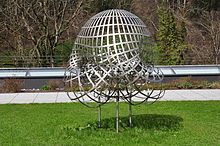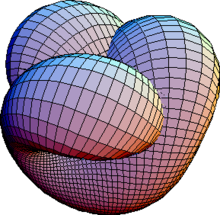Boyian surface
The Boy surface is a geometric object. It is an immersion of the real projective plane in three-dimensional space. Werner Boy discovered the area named after him in 1901. Like the Klein bottle , it has self-intersections, but also a triple point.
background
The real projective plane is the simplest non-orientable closed surface. It is created from the Möbius strip by gluing a circular disc to its edge.
Like all non-orientable closed surfaces, the projective plane cannot be embedded in the.
The Boyian surface at least realizes an immersion of the projective plane in the . Werner Boy constructed this surface as a counterexample to an assumption by David Hilbert that there were no immersions of the projective plane in the . Boy was able to make several drawings of this surface and discovered its possible threefold rotational symmetry , but could not find a parametric representation for it. It was not until 1978 that Bernard Morin found a computer-aided parameterization.
The first analytical representation was given in 1981 using a semi-empirical method. This consists of describing the meridians of the surface using ellipses, which are then parameterized.
In the meantime there are numerous parameterizations of Boy surfaces, for example using polynomials of the 4th degree.
Bryant-Kusner parameterization
The following parameterization is defined for complex numbers with .
With
Opposite points on the edge of the unit circle disk have the same image point, so it is actually a parameterization of a projective plane.
This parameterization minimizes the Willmore energy among all immersions of the projective plane in the .
Model in Oberwolfach

In front of the Mathematical Research Institute in Oberwolfach, there is a model of the Boy surface, donated by Mercedes-Benz in 1991 . This model has a 3-order symmetry group and minimizes the Willmore energy . It consists of steel strips that represent the image of the polar coordinate network in the Bryant-Kusner parameterization. The radial strips (images of the rays ) are ordinary Möbius strips that are twisted once . The longitudinal stripes (pictures of the circles ) are untwisted with one exception, the exception (corresponds ) is a triple-twisted Möbius strip , as it is also used in the emblem of the Mathematical Research Institute.
swell
- ^ Math World: Boy Surface
- ^ Robert Bryant: Surfaces in conformal geometry, The mathematical heritage of Hermann Weyl (May 12-16, 1987, Duke University, Durham, North Carolina). In: Proc. Sympos. Pure Math. 1988. Volume 48, Amer. Math. Soc., Providence, RI, pp. 227-240.
- ^ Hermann Karcher, Ullrich Pinkall: The Boysche area in Oberwolfach. (PDF; 213 kB) on: mfo.de
Web links
- mathcurve.com: Surface de Boy Retrieved November 18, 2011 (French)






![{\ displaystyle {\ begin {aligned} g_ {1} & = - {3 \ over 2} \ mathrm {Im} \ left [{t (1-t ^ {4}) \ over t ^ {6} + { \ sqrt {5}} t ^ {3} -1} \ right] \\ g_ {2} & = - {3 \ over 2} \ mathrm {Re} \ left [{t (1 + t ^ {4}) ) \ over t ^ {6} + {\ sqrt {5}} t ^ {3} -1} \ right] \\ g_ {3} & = \ mathrm {Im} \ left [{1 + t ^ {6 } \ over t ^ {6} + {\ sqrt {5}} t ^ {3} -1} \ right] - {1 \ over 2} \ end {aligned}}}](https://wikimedia.org/api/rest_v1/media/math/render/svg/12fcfeb70c1a58798d5ae8748c01574d8a32bc9c)


